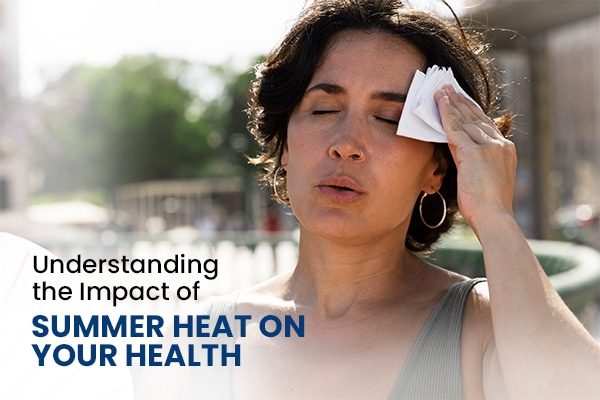The Health Risks Associated with Summer Heat

Summer heat can pose several health risks, especially when temperatures soar to extreme levels. Understanding these risks and how to mitigate them is crucial for maintaining health and safety during the hottest months. Here are some common health risks associated with summer heat:
1. Heat-Related Illnesses
- Heat Exhaustion: This occurs when the body overheats due to prolonged exposure to high temperatures, especially when combined with high humidity. Symptoms include heavy sweating, weakness, dizziness, nausea, headache, and muscle cramps. If not treated, it can lead to heat stroke.
- Heat Stroke: A severe, life-threatening condition that occurs when the body’s temperature regulation fails, leading to a body temperature above 104°F (40°C). Symptoms include confusion, altered mental state, rapid heartbeat, hot and dry skin, and unconsciousness. Immediate medical attention is necessary.
- Heat Cramps: Painful muscle spasms, usually in the legs or abdomen, caused by heavy sweating and loss of salts and minerals during intense physical activity.
2. Dehydration
- Increased Risk: High temperatures increase the risk of dehydration as the body loses more water through sweating. Symptoms of dehydration include dry mouth, excessive thirst, dark urine, fatigue, and dizziness.
- Electrolyte Imbalance: Along with water, the body loses essential electrolytes like sodium, potassium, and magnesium, which can lead to further complications such as muscle cramps and irregular heartbeats.
3. Sunburn and Skin Damage
- Sunburn: Prolonged exposure to the sun’s ultraviolet (UV) rays can cause sunburn, characterized by red, painful skin that may blister and peel. Severe sunburn can lead to swelling, fever, and chills.
- Long-term Skin Damage: Repeated sun exposure increases the risk of premature skin aging and skin cancers, including melanoma, basal cell carcinoma, and squamous cell carcinoma.
4. Heat Rash
- Prickly Heat: Also known as prickly heat or miliaria, heat rash occurs when sweat ducts become blocked and swell, leading to red, itchy bumps on the skin. It is common in hot and humid conditions.
5. Exacerbation of Preexisting Conditions
- Cardiovascular Issues: High temperatures can strain the cardiovascular system, increasing the risk of heart attacks and strokes, especially in people with preexisting heart conditions.
- Respiratory Problems: Hot, polluted air can exacerbate respiratory conditions such as asthma and chronic obstructive pulmonary disease (COPD).
6. Heat Syncope
- Fainting: Heat syncope involves a sudden drop in blood pressure due to prolonged standing or sudden changes in posture in the heat, leading to fainting. It’s more common in older adults and those not acclimated to high temperatures.
7. Hyperthermia in Vulnerable Populations
- Elderly: Older adults are more susceptible to heat-related illnesses due to decreased ability to regulate body temperature and the presence of chronic health conditions.
- Infants and Young Children: Young children are also at higher risk due to their small body size and undeveloped temperature regulation systems.
- People with Chronic Illnesses: Individuals with chronic health conditions such as diabetes, heart disease, and obesity may have increased susceptibility to heat-related illnesses.
- Athletes and Outdoor Workers: People who engage in strenuous physical activity or work outdoors in hot conditions are at a higher risk of heat-related health issues.
8. Foodborne Illnesses
- Food Spoilage: High temperatures can cause food to spoil more quickly, increasing the risk of foodborne illnesses. Proper food handling and storage are essential to prevent bacterial growth.
9. Eye Damage
- UV Exposure: Excessive exposure to UV rays can damage the eyes, leading to conditions such as photokeratitis (sunburn of the cornea) and increasing the risk of cataracts and other eye disorders.
Preventive Measures
- Stay Hydrated: Drink plenty of fluids, especially water, to stay hydrated. Avoid alcohol and caffeine, which can contribute to dehydration.
- Wear Appropriate Clothing: Lightweight, loose-fitting, light-colored clothing helps to keep cool. Wearing a wide-brimmed hat and sunglasses can protect against UV rays.
- Apply Sunscreen: Use a broad-spectrum sunscreen with an SPF of at least 30 to protect against sunburn and skin damage.
- Limit Outdoor Activities: Avoid strenuous activities during the hottest parts of the day (usually between 10 a.m. and 4 p.m.). Take frequent breaks in shaded or air-conditioned areas.
- Use Fans and Air Conditioning: Keep cool indoors using fans and air conditioning. Public places like shopping malls and libraries can provide a cool refuge.
- Monitor Vulnerable Individuals: Check on elderly neighbors, young children, and people with chronic illnesses to ensure they are coping with the heat.
- Recognize Symptoms Early: Be aware of the signs of heat-related illnesses and take prompt action if symptoms appear.
By understanding these health risks and taking appropriate precautions, individuals can protect themselves and others from the adverse effects of summer heat.
Thank you,

